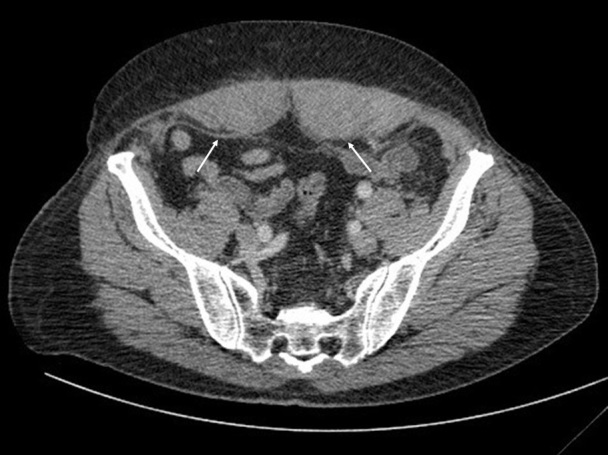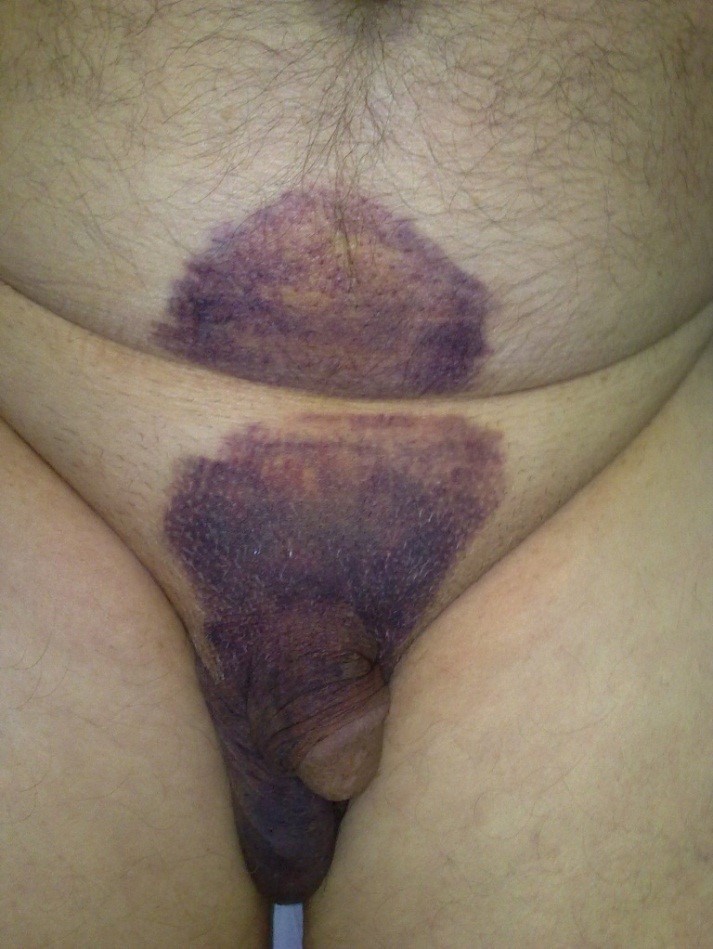Abstract
A 67-year-old man presented to the emergency department with abdominal pain and groin bruising. He had no history of any disease or drug use. In his breaf story he had a heavy cough five days ago and bruises appeared on the abdomen skin and groin in the last two days. Ecchymosis extends in the midline from umblicus to the penis and scrotum in physical examination (Figure 1). Laboratory evaluation revealed normal hemoglobin level, platelet count, prothrombin time, and activated partial thromboplastin time.
DIAGNOSIS
Abdominal rectus muscle hematoma was detected on abdomen computed tomography (Figure 2). We thought that rectus sheath hematoma appeared after heavy coughing. The patient was given a supportive treatment and after twenty days of follow up, the hematoma was disappered without any complications.
Figure 2.

Abdomen computed tomography showing rectus sheath hematoma (arrows).
Heavy cough can cause rectus sheath hematoma.1 Rectus sheath hematoma should be considered in elderly patients on anticoagulant treatment with abdominal pain.2 The frequent clinical findings are abdominal mass and pain.1–3 The patients should be followed up for loss of blood and enlargement of the hematoma. Fatal complications are rarely seen and supportive treatment is adequate.
Figure 1.

Appearance of the patient’s abdomen and groin.
Footnotes
Supervising Section Editor: Sean O. Henderson, MD
Full text available through open access at http://escholarship.org/uc/uciem_westjem
Conflicts of Interest: By the WestJEM article submission agreement, all authors are required to disclose all affiliations, funding sources and financial or management relationships that could be perceived as potential sources of bias. The authors disclosed none.
REFERENCES
- 1.Cherry WB, Mueller PS. Rectus sheath hematoma: review of 126 cases at a single institution. Medicine (Baltimore) 2006;85(2):105–10. doi: 10.1097/01.md.0000216818.13067.5a. [DOI] [PubMed] [Google Scholar]
- 2.Golcuk Y, Oray D, Bademkiran E. Type III Rectus Sheath Hematoma: A Case Report. Tr J Emerg Med. 2012;12(1):38–40. [Google Scholar]
- 3.Salemis NS, Gourgiotis S, Karalis G. Diagnostic evaluation and management of patients with rectus sheath hematoma. A retrospective study. Int J Surg. 2010;8(4):290–3. doi: 10.1016/j.ijsu.2010.02.011. [DOI] [PubMed] [Google Scholar]


